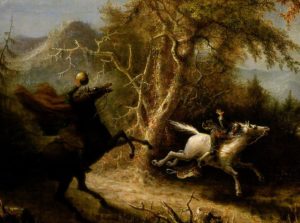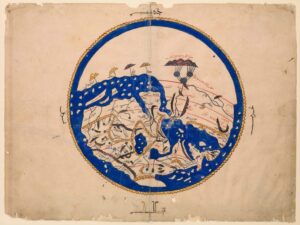Ichabod Crane, a name widely recognized from Washington Irving’s classic tale “The Legend of Sleepy Hollow”, has long been associated with the image of a lanky, superstitious schoolteacher who is ultimately frightened away by the notorious Headless Horseman. However, behind the fictional character lies the real Ichabod Crane, a distinguished military officer whose career was vastly different from his portrayal in Irving’s tale. The real Ichabod Crane’s life and legacy offer a fascinating glimpse into the intertwining of history and fiction, as well as the ways in which storytelling can transform and adapt historical figures into enduring characters in popular culture.
The Real Ichabod Crane: A Military Legacy
Born on July 18, 1787, in Elizabethtown, New Jersey, the real Ichabod Crane embarked on a military career that would span nearly five decades. His distinguished service included roles as both a U.S. Marine and an officer in the U.S. Army, and he achieved the rank of colonel before his retirement in 1857. Crane’s military career began in 1809 when he joined the Marine Corps, later transferring to the Army during the War of 1812. Throughout his service, he was stationed at various posts across the country, and his experiences ranged from combat in the War of 1812 to overseeing military installations in the western territories.
One of the most notable chapters of Crane’s career occurred during the War of 1812, when he served under General Jacob Brown. His military service during this period helped solidify his reputation as a capable and brave officer. After the war, Crane continued his career in the military, where he held several important command positions, including the oversight of Fort Pike, a strategic military post in Louisiana. His career would later take him to various frontier posts, reflecting the westward expansion of the United States in the early 19th century.
The Connection Between Fact and Fiction
The connection between the real Ichabod Crane and Washington Irving’s “The Legend of Sleepy Hollow” is intriguing, as it reveals the fluid boundary between history and storytelling. Irving wrote the tale in 1820, and many scholars believe that he based his fictional character on the real-life Crane, whom Irving may have met during the War of 1812. Irving himself was an aide-de-camp to New York Governor Daniel D. Tompkins, and it’s plausible that he crossed paths with Crane during this time. However, the similarities between the two Ichabod Cranes largely end with the name, as Irving’s portrayal of the character differs greatly from the real-life officer.
In “The Legend of Sleepy Hollow”, Ichabod Crane is depicted as a schoolteacher from Connecticut who moves to the small town of Sleepy Hollow in the Hudson Valley. The character is described as tall and lanky, with a penchant for the supernatural and a particularly awkward and cowardly demeanor. His interest in the local farmer’s daughter, Katrina Van Tassel, becomes a central plot point, as does his fateful encounter with the legendary Headless Horseman, which ultimately leads to his mysterious disappearance.
The real Ichabod Crane, by contrast, was far from the bumbling, superstitious figure portrayed in the story. As a military officer, Crane was well-respected, disciplined, and devoted to his duties. His life was defined by service to his country, not by a fear of ghosts or an obsession with local legends. Nevertheless, Washington Irving’s decision to borrow Crane’s name for his fictional character speaks to the power of storytelling and how real-life figures can be transformed into literary symbols that take on lives of their own.
The Power of Transformation Through Storytelling
Washington Irving’s use of the name Ichabod Crane in his tale highlights the ways in which historical figures can be reimagined and reshaped within fictional narratives. In “The Legend of Sleepy Hollow”, Crane’s awkwardness, superstition, and physical appearance make him a memorable and somewhat humorous figure, whose ultimate fate is both mysterious and unsettling. Irving’s Crane is a man out of place in the rural, haunted landscape of Sleepy Hollow, a stark contrast to the robust and capable soldier that the real Ichabod Crane was known to be.
This transformation reflects the broader power of storytelling to create enduring myths and legends that may not necessarily align with historical facts. In this case, the real Ichabod Crane becomes a mere shadow of himself within Irving’s story, transformed from a seasoned military officer into a caricature of fear and awkwardness. Yet it is precisely this exaggeration and distortion that has allowed the character of Ichabod Crane to endure in the public imagination for centuries.
The Enduring Popularity of “The Legend of Sleepy Hollow”
The character of Ichabod Crane and the tale of the Headless Horseman have become deeply ingrained in American folklore, thanks in large part to Irving’s skillful blending of historical setting, local legend, and imaginative storytelling. Sleepy Hollow itself, located in Tarrytown, New York, has become synonymous with the eerie tale, attracting visitors from around the world who are eager to explore the haunted landscape that Irving so vividly described.
Over the years, “The Legend of Sleepy Hollow” has been adapted into numerous films, television shows, and even animated features, further cementing the tale’s place in popular culture. Each adaptation has offered a slightly different interpretation of Ichabod Crane, with some emphasizing his awkwardness and cowardice, while others highlight his intelligence and curiosity. Nevertheless, the character’s transformation from a real-life figure to a fictional icon is a testament to the enduring appeal of Irving’s story.
Interestingly, the real-life Sleepy Hollow does bear some resemblance to the setting of Irving’s tale. The town, with its picturesque rolling hills and dense forests, offers an atmosphere that can easily be imagined as the haunt of ghostly figures. Irving’s genius was in taking the landscape and history of the Hudson Valley and infusing it with elements of the supernatural, creating a world where fact and fiction blend seamlessly.
Ichabod Crane’s Legacy in History and Fiction
While the fictional Ichabod Crane continues to captivate readers and audiences, the real Ichabod Crane’s legacy remains somewhat sequestered by his literary counterpart. Nevertheless, Crane’s contributions to the U.S. military were significant, and his career reflected the challenges and complexities of military service in the early 19th century. As a veteran of the War of 1812 and a dedicated officer, Crane played a key role in shaping the military presence in the expanding American frontier.
Interestingly, despite the differences between the real and fictional Cranes, both figures share a certain sense of displacement. In “The Legend of Sleepy Hollow” Ichabod Crane is a man out of his element, struggling to navigate the superstitions and folklore of the rural town. Similarly, the real Ichabod Crane spent much of his career on the frontier, overseeing remote military outposts far from the bustling cities of the East Coast. In both cases, the figure of Crane represents a character who is in some way caught between worlds—whether it be between the civilized world and the frontier or between the rational and the supernatural.
This sense of displacement adds another layer of complexity to the Crane figure, making him more than just a caricature of fear or awkwardness. Instead, both the real and fictional Cranes can be seen as symbols of individuals navigating unfamiliar or challenging environments, whether those challenges are external (as in the case of the real Crane’s military career) or internal (as in the fictional Crane’s fears and superstitions).
The story of Ichabod Crane, both real and fictional, offers a fascinating look at the ways in which history and storytelling can intersect and diverge. While Washington Irving’s “The Legend of Sleepy Hollow” is a work of fiction, its connections to real people and places give it a unique resonance that continues to captivate audiences today. The real Ichabod Crane, a decorated military officer with a long and distinguished career, lives on not just in the annals of military history but also in the world of literature, where his name has become synonymous with one of America’s most enduring ghost stories.
In the end, the real and fictional Ichabod Cranes are both figures who have been transformed by their respective contexts—one by the realities of military life and the other by the imagination of a master storyteller. Together, they remind us of the power of narrative to shape and reshape our understanding of history, myth, and the individuals who populate both.
No comments yet.







